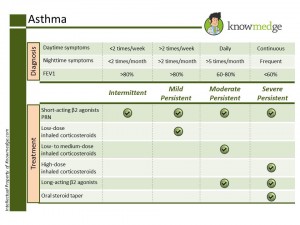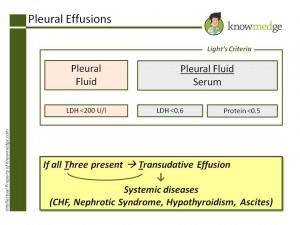8 Pulmonary & Critical Care Pearls for the Internal Medicine Shelf and ABIM Board Exam
Pulmonary disease and critical care are an extremely important part of the Internal Medicine Medical Clerkship and ABIM Board exam. According to the ABIM exam blueprint, questions testing pulmonary disease topics comprises ~10% of the exam. That places it second only to cardiology’s 14% in terms of relative percentage.
1. ABGs do not need to stand for AnyBody’s Guess
The next time you see an arterial blood gas (ABG) on a practice or actual exam question, don’t start searching for the “Panic” (or “Skip”) button. Determining diagnoses based on ABGs can seem daunting at first but by following a simple yet systematic approach, we can tackle these questions without difficulty. Click on the link to our previous “How to Handle ABGs on the ABIM Board Exam” and after reviewing the 5 easy steps, it won’t be long before you look forward to ABG questions on the exam.
2. Obstructive or Restrictive? That is the question surrounding Lung Disease
To distinguish between obstructive and restrictive lung disease, the first value to look at on the pulmonary function test (PFT) report is the Total Lung Capacity (TLC), which is defined as the volume of air contained in the lungs at the end of a maximal inspiration.
- Obstructive Lung Disease: TLC will be increased (example: asthma and COPD)
- Restrictive Lung Disease: TLC will be decreased. Restrictive Lung Disease is further sub-divided into intra-thoracic and extra-thoracic lung disease.
- Intra-thoracic lung Disease (FEV1/FVC normal or increased above 80%, DLCO decreased, Residual Volume decreased)
- Sarcoidosis
- Idiopathic Pulmonary Fibrosis
- Hypersensitivity Pneumonitis
- Pneumoconiosis
- ABPA
- Churg-Strauss Syndrome
- Asbestosis
- Silicosis
- Berylliosis
- Extra-thoracic Lung Disease (FEV1/FVC normal or increased above 80%, DLCO normal, Residual Volume increased)
- Obesity
- Kyphosis
- Myasthenia Gravis
- Guillain-Barre Syndrome
- Muscular dystrophy
3. The Mnemonic “CHAD PARS” helps recall the major causes of bronchiectasis.
- C – CYSTIC FIBROSIS
- H – HYPOGAMMAGLOBULINEMIA
- A – ALPHA 1 ANTITRYPSIN DEFICIENCY
- D – DYSKINETIC CILIARY SYNDROME
- P – PNEUMONIA
- A – ALLERGIC BRONCHOPULMONARY ASPERGILLOSIS (ABPA)
- R – RHEUMATOID ARTHRITIS
- S – SJOGREN’S SYNDROME
4. Not all that wheezes is asthma…but it sure is important for the ABIM boards and medicine shelf exam
Frequency of asthma symptoms provides the necessary information for proper classification of this reversible obstructive lung disease (defined by greater than or equal to 12% increase in the FEV1 after use of an albuterol inhaler). Only then can we determine the best treatment for the affected patient in an exam vignette.
This slide (click on it for enlarged view) conveniently depicts the criteria for intermittent, mild persistent, moderate persistent, and severe persistent asthma, along with their recommended treatments.
ABIM Exam Pearls: Asthma Treatment and Diagnosis

5. Similarly, mastering COPD classification (using the GOLD criteria) and treatment is essential
Unlike asthma, COPD is an irreversible condition. Administering the bronchodilator albuterol will not increase FEV1.
GOLD (Global Initiative for Chronic Obstructive Lung Disease) criteria is the primary method used to diagnose and identify the severity of COPD. A diagnosis of COPD should be considered for any patient over the age of 40 who has any of the following conditions:
- Dysnea that is persistent, worsens over time and gets worse with exercise
- Chronic cough
- Chronic sputum production
- History of exposure to risk factors (Tobacco smoke, smoke from home cooking, occupational dust, chemicals)
- Family history of COPD
FEV1/FVC ratio less than 70% is an indication that there is an airflow limitation and, thus, COPD. The spirometric criteria for a diagnosis of COPD is a post-bronchodilator FEV1/FVC ratio less than 70%.
FEV1 will tell us the intensity of the COPD which can be characterized into four stages:
- Stage I (Mild): FEV1 > 80% of predicted value; Rx: Short acting Bronchodilator as needed with or without Ipratropium
- Stage II (Moderate): 50% ≤ FEV1 < 80% of predicted value; Rx: Short acting Bronchodilator as needed with long acting bronchodilator around the clock with or without pulmonary rehab
- Stage III (Severe): 30% ≤ FEV1 < 50% of predicted value; Rx: As above for moderate COPD plus Inhaled steroids
- Stage IV (Very severe): FEV1 < 30% of predicted value (or FEV1 < 50% of predicted value plus chronic respiratory failure); Rx: As above for severe COPD plus Long-term oxygen therapy for at least 15 hours daily. Surgical intervention should be considered.
The slide below (click for enlarged view) reveals the cut-off criteria for the different stages.
ABIM Exam Pearls: GOLD Criteria for COPD

Other indications for Oxygen therapy in COPD patients are:
- PaO2 less than 55 mm Hg or Oxygen saturation less than 88% OR
- PaO2 less than 59 mm Hg or Oxygen saturation greater than 88% with evidence of Cor pulmonale (Right ventricular dysfunction) or secondary erythrocytosis (hematocrit greater than 55%)
6. IgE and Eosinophil levels help us distinguish ABPA, Hypersensitivity pneumonitis, and Churg-Strauss syndrome
ABPA → Increased IgE levels and increased peripheral eosinophils >10% → Rx with steroids
HYPERSENSITIVITY PNEUMONITIS → IgE levels and peripheral eosinophils are normal → Remove offending agent
CHURG-STRAUSS SYNDROME → IgE levels are normal, peripheral eosinophils >10% → (Clue: asthmatic patient with increase peripheral eosinophils and a foot drop) → Management with steroids
7. Light’s criteria will guide you to correctly identifying Pleural Effusions as either exudative or transudative
Broken down into Transudative and Exudative effusion. Remember that for Transudate, all of the following need to be met. If all are not met, then the patient has an exudative effusion.
ABIM Exam Pearls: Light’s Criteria

- Transudate effusions include conditions such as: CHF, Nephrotic syndrome, Cirrhosis, Hypothyroidism
- Exudative effusions include conditions such as: Neoplasm, Infection, RA, SLE, Esophageal perforation, Pancreatitis, and Dressler Syndrome
8. Bronchoalveolar lavage (BAL) findings can help narrow down, if not nail, the diagnosis.
- Increased Neutrophils → think Idiopathic Pulmonary Fibrosis
- Increased CD8>CD4 → think Hypersensitivity Pneumonitis
- Increased CD4>CD8 → think Sarcoidosis
- Increased Eosinophils → think Eosinophilic pneumonia
- Positive Silver Methanamine Stain → think Pneumocystis Jiroveci in patients with HIV
- Inclusion bodies → think CMV pneumonia
Once again, the folks who write the Internal Medicine licensing exams don’t expect you to have the depth of knowledge regarding lung conditions that a pulmonologist possesses. However, topics such as the ones mentioned in the slides and pearls above should assist you with the pulmonary section of the med school clerkship shelf and ABIM board exams.







